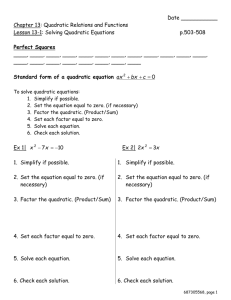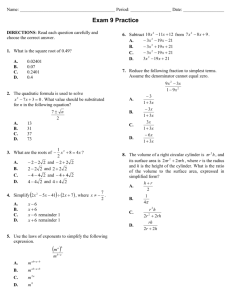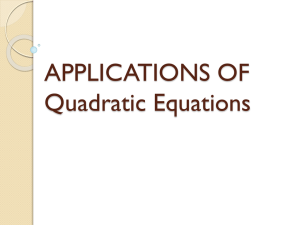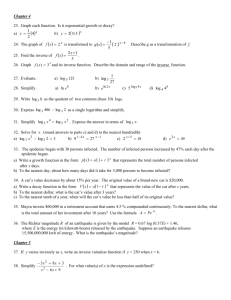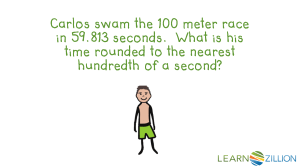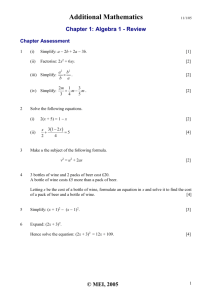Advanced Algebra with Trigonometry
advertisement
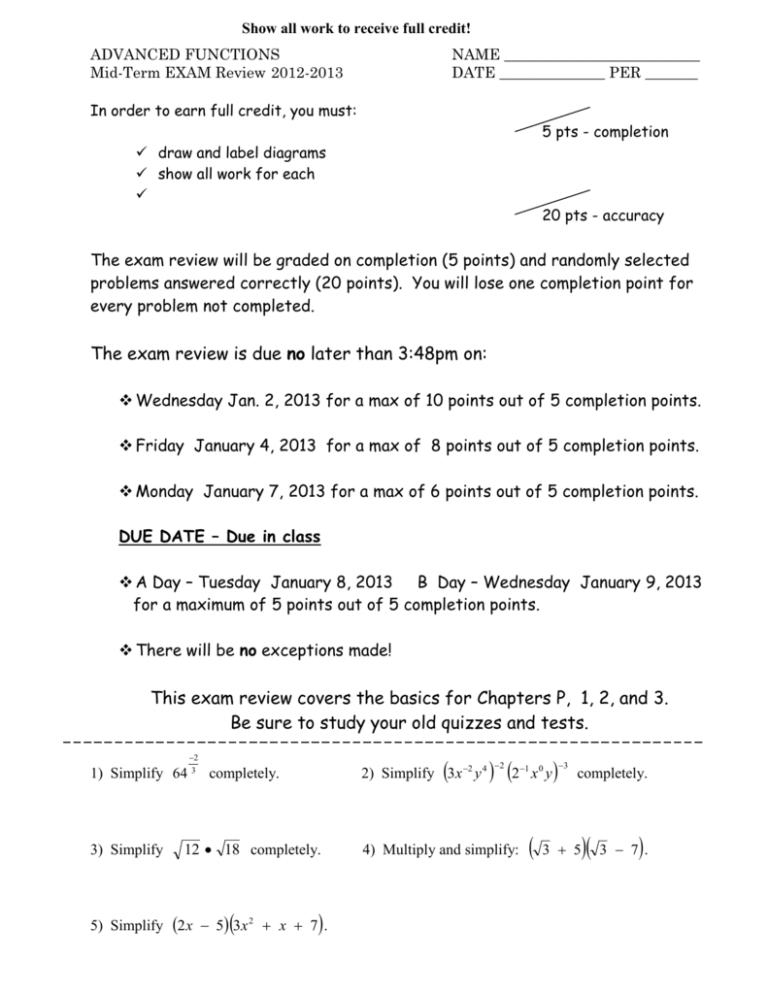
Show all work to receive full credit! ADVANCED FUNCTIONS aa Mid-Term EXAM Review 2012-2013 NAME __________________________ DATE ______________ PER _______ In order to earn full credit, you must: 5 pts - completion draw and label diagrams show all work for each 20 pts - accuracy The exam review will be graded on completion (5 points) and randomly selected problems answered correctly (20 points). You will lose one completion point for every problem not completed. The exam review is due no later than 3:48pm on: Wednesday Jan. 2, 2013 for a max of 10 points out of 5 completion points. Friday January 4, 2013 for a max of 8 points out of 5 completion points. Monday January 7, 2013 for a max of 6 points out of 5 completion points. DUE DATE – Due in class A Day – Tuesday January 8, 2013 B Day – Wednesday January 9, 2013 for a maximum of 5 points out of 5 completion points. There will be no exceptions made! This exam review covers the basics for Chapters P, 1, 2, and 3. Be sure to study your old quizzes and tests. 1) Simplify 64 3) Simplify 2 3 2) Simplify 3x 2 y 4 completely. 12 18 completely. 5) Simplify 2 x 5 3x 2 x 7 . 2 2 4) Multiply and simplify: 1 x0 y 3 completely. 3 5 3 7 . #6-10 Factor completely. 7) 48x 2 3 6) 27m3n 9mn 8) x 2 3x 54 9) x 3 27 11) Factor by grouping to find all solutions of 10) 2 x 2 3x 12 x 3 2x 2 x 2 0 . x 2 7 x 12 x 2 6x 8 3 12) (Section P.5) Simplify completely. State the Domain!! x3 1 x x2 x 13) (Section P.5) Simplify 3x 6 2 completely. State the LCD and the Domain!! x 4 x 4 2 #14-17 Solve the following equations. 14) Solve for a. 2 a – 12 = 3(a + 7) 5 16) Solve for x. 7x 6x 7 3 4 8 2 15) Solve for x. 17) Solve for x. 2( x 3)2 7 31 2 4x 6 8 4 #18) Solve each quadratic by graphing. (You must show at least 5 point including the vertex.) y x 2 2 x 24 0 x 19) Solve the quadratic 81x 2 49 0 by factoring. 20) Find the discriminant of 2 x 2 x 1 0 . Describe the nature of the root(s). 21) Solve the quadratic 3x 2 2 x 5 0 using the quadratic formula. 22) Solve the quadratic x 2 16 x 46 0 by completing the square. Simplify completely. 23) Graph the relation and determine whether the relation is a function and/or one-to-one. Explain your answer. y y 4 x 6 x 24) Evaluate 3.1. 26) Find the slope of the line passing through 25) Given f ( x) x 3 7 , find f (2) . 2, 6 and 3, 9 . 27) State the domain of f ( x) x 6. 28) Find the y-intercept for f ( x) 2 x 3 3x 2 12 x 29) Find the slope and the y-intercept of the line passing through 8, 11 and 4, 11 . y 30) Write the equation shown by the graph. x _______________________ 31) Write the slope-intercept form of the equation of the line passing through 4, 4 and 5, 10 . 32. Look at the graphs. Determine if it is a function and/or one-to-one, or neither AND EXPLAIN WHY YOU DECIDED THIS. Circle all that applies. a. b. Function / One-to-One / Neither Function / One-to-One / Neither REASON ____________________ REASON ____________________ 33) Graph the piecewise function: x 1, x 0 f ( x) . 2 x 1, x 0 y x **********************UNIT 3*********************** 34) Divide x 3 4 x 2 12 x 9 by x 2 using SYNTHETIC division. 35) Divide 3x 2 6 x3 16 x 2 23x 5 using LONG division. 36) Find f (2) if f ( x) 3x3 6 x 2 7 x 10 using the Remainder Theorem. 37) What is happening with this graph? y As x , f (x) _________. f (x) As x , f (x) _________. How many turning points does this graph have? _____ What is the lowest degree of this polynomial? _____ What is the sign of the leading coefficient? _______________ 38) What happens at x 4 if y ( x 3)3 ( x 4)4 . 39) Use the Zero Location Theorem to determine if P( x) 3x3 11x 2 6 x 8 has a real zero between x = -2 and x = -3. EXPLAIN WHY OR WHY NOT. 40) Find the zeros of P (x ) and state the multiplicity of each zero. x P ( x) x 3 x 2 3 x 2x 3 1 2 _____ occurs as a zero of multiplicity _____ . _____ occurs as a zero of multiplicity _____ . _____ occurs as a zero of multiplicity _____ . _____ occurs as a zero of multiplicity _____ . 41) Find all the zeros of P( x) 3x3 11x 2 6 x 8 . Determine the number of zeros and also include the use of the Rational Root Theorem and Descartes’ Rule of Signs. Be able to do this without the use of a calculator. 42) Write the polynomial of least degree for the roots of 3i , 3i , and 2 . _____ 43) Determine the far-left and the far-right end behavior of the graph of P( x) 0.02 x6 4 x3 0.01x 2 200 . Create a sketch of the graph. a) As x , f ( x) ; x , f ( x) b) As x , f ( x) ; x , f ( x) c) As x , f ( x) ; x , f ( x) d) As x , f ( x) ; x , f ( x) 3x 6 . 2 x 5x 2 Hole in graph: __________ 44) Graph f ( x) 2 V.A. __________ H.A. __________ Quick Sketch: y x x-intercept __________ y-intercept __________ slant asymptote __________ Domain __________ Range __________ x y x y 45) Sketch the graph of f ( x) x3 6 x 2 9 x . Label x- and y-intercepts, maximum and minimum points, and the graph. USE CALC TO FIND MAX/MIN. y HINT: You need to factor first. x y Relative maximum: __________ Relative minimum: __________ ZEROS ______________ x 46) Explain why this polynomial has a slant asymptote and find it. F ( x) x 2 3x 1 . x 1 47) At most, how many roots could the polynomial f ( x) 4 x9 3x6 10 x3 8 x 2 have? EXPLAIN WHY. **************************UNIT 3.14************************ Simplifying radicals review. No decimal answers!! Use Sections P1/P2 in your book for help if you are going to turn this in early. 48) 225a 2 b3 using rational exponents. Express 49) Express x x 50) How would you write 493/5 in radical notation? 51) How would you write 3 64 5 5 4a8b14c5 2 x 2 y 54) 3 3 xy 2 5 using radicals. ____________________________________ in exponential notation? _______________________________ Simplify the following expressions. 52. 3 5 53. 2 55) 3 16w2 x 4 y14 3 2 *****************LABS/REGRESSION PROBLEM****************** Automotive Engineering: The fuel efficiency, in miles per gallon, for a certain midsize car at various speeds, in miles per hour, is given in the table below. mph mpg 25 29 30 32 35 33 ___________________________ ___________________________ ____________________ ____________________ 40 35 45 34 50 33 55 31 60 28 65 24 70 19 75 17 1a. Find a linear model for these data. Round to the nearest hundredth. 1b. Find a quadratic model for these data. Round to the nearest hundredth. 2a. What is the coefficient of determination(r2) for the linear model? Round to the nearest hundredth. 2b. What is the coefficient of determination(r2) for the quadratic model? Round to the nearest hundredth. ____________________ 2c. Which model (linear or quadratic) is a better predictor of the data? WHY? ____________________ 3a. Use your model from #1 to predict the fuel efficiency of this car when it is traveling at a speed of 27 mph. Show work. Round to the nearest tenth. Give proper units. ____________________ 3b. Use your model from #1 to predict the fuel efficiency of this car when it is traveling at a speed of 5 mph. Show work. Round to the nearest tenth. Give proper units. _____________________ 4. Use the quadratic formula to find the possible speeds that a midsize car can go to average 20 miles per gallon. Round your solutions to the nearest tenth. Do not round until your final solutions. 3.1 – The Remainder and Factor Theorem 5. Selection of Cards The number of ways you can select three cards from a stack of n cards, in which the order of selection is important, is given by P(n) n3 3n2 2n, n 3 a. Use the Remainder Theorem to determine the number of ways you can select three cards from a stack of n = 8 cards. b. Evaluate P(n) for n = 8 by substituting 8 for n. How does the result compare with the result obtained in part a.? 6. Profit A software company produces a computer game. The company has determined that is profit P, in dollars, from the manufacture and sale of x games is given by P( x) 0.000001x3 96 x 98, 000 where 0 x 9000 . (Hint: Use your calculator to graph the function, use ZoomFit, and then CALC the MAXIMUM) a. What is the maximum profit, to the nearest thousand dollars, the company can expect from the sale of its games? b. How many games, to the nearest unit, does the company need to produce and sell to obtain the maximum profit? Modeling Launched Objects The function h 16t 2 h0 was used to model the height of a dropped object. For an object that is launched or thrown, an extra term v0t must be added to the model to account for the object’s initial vertical velocity v0 (in feet per second). Recall that h is the height (in feet), t is the time in motion (in seconds), and h0 is the initial height (in feet). 7. Juggling: A juggler tosses a ball into the air. The ball leaves the juggler’s hand 4 feet above the ground and has an initial vertical velocity of 40 feet per second. The juggler catches the ball when it falls back to a height of 3 feet. How long is the ball in the air? Round to the nearest hundredth ____________ 8. Football: In a football game, a defensive player jumps up to block a pass by the opposing team’s quarterback. The player bats the ball downward with his hand at an initial vertical velocity of -50 feet per second when the ball is 7 feet above the ground. ______________ How long do the defensive players’ teammates have to intercept the ball before it hits the ground? Round to the nearest hundredth.
